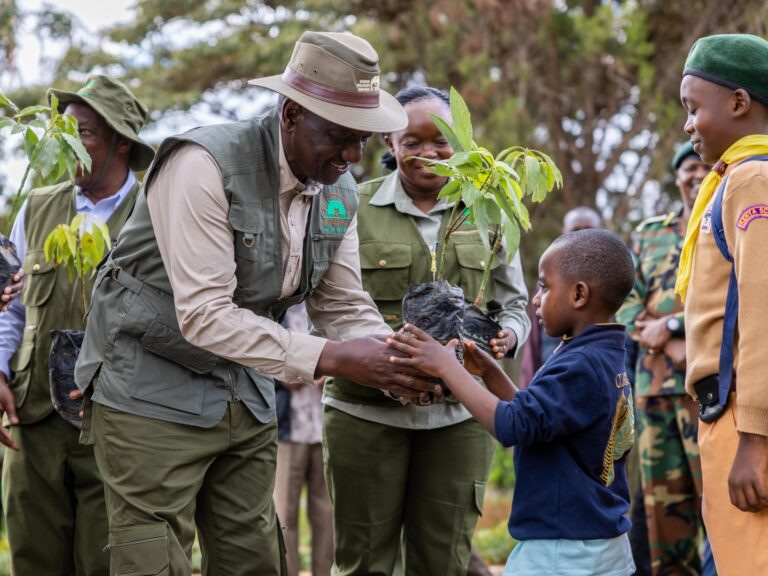
A farmer sprays crops in Kenya, where microplastic contamination is an emerging threat to soil and food safety. (Photo/Courtesy).
By Daisy Okiring | Investigative Environmental Series
Nairobi, Kenya | 26th July 2025
It’s tasteless, odourless, and invisible — but it’s likely on your plate. The average human is consuming up to 5 grams of microplastics weekly, roughly the size of a bottle cap, according to a 2024 study by the World Wildlife Fund (WWF) and the University of Newcastle. That adds up to a staggering 250 grams annually — equivalent to eating a credit card each week.
In Kenya, where many depend on subsistence farming and informal markets, the threat is even greater. Microplastics — fragments less than 5mm in size — have infiltrated farms, food, fish, and water. And as these particles move from soil to stomach, they are silently compromising national food safety, nutrition, and health.
“Plastic is no longer just a pollutant. It’s part of our food system now,” says environmentalist Elizabeth Wathuti, founder of the Green Generation Initiative.
Kenyan soils — From fertile ground to plastic dumps
In the fields of Kirinyagaachakos, and Meru, something invisible is changing the soil. Farmers may not see it, but scientists do. Microplastic contamination is quietly transforming Kenya’s farmlands.
Also Read: Lake Bogoria turns red—science says climate change, villagers say judgment day
A 2025 survey by the University of Nairobi found microplastic particles in 68% of soil samples collected from agricultural land near urban centres. These particles — including polyethylene, polystyrene, and nylon — originate from decayed packaging, plastic mulch, polluted irrigation water, and sewage sludge used as compost.
“Microplastics disrupt soil fertility, water retention, and microbial life,” explains Dr. Nancy Wanjiku, environmental chemist at Kenyatta University. “We’re witnessing a new type of soil degradation.”
Across Africa, the problem is widespread. A 2022 UNEP report found plastic contaminants in 46% of agricultural plots tested in East Africa. Kenya’s proximity to plastic-producing urban areas and limited waste treatment makes its farms particularly vulnerable.

Contaminated crops — The plastic in your Sukuma Wiki
The problem doesn’t stop in the soil. Microplastics are now appearing inside edible plant tissue. Research by the Kenya Agricultural and Livestock Research Organization (KALRO) confirms the presence of plastic particles in spinach, kale, maize, and cabbage collected from peri-urban farms.
Plants absorb plastics through their roots. Tiny particles move into vascular tissues — especially in leafy greens — and become embedded in the edible parts of the plant. These particles are invisible to the naked eye and resistant to washing or boiling.
“In our lab, we found plastic particles inside the xylem vessels of sukuma wiki,” says Dr. Richard Karani, a plant biologist at KALRO. “This isn’t a surface problem — it’s systemic.”
Kenya is not alone. A 2023 study published in Environmental Pollution found microplastics in carrots and apples in Spain, cassava in Nigeria, and onions in Egypt. The contamination has gone global, threatening the foundational crops that feed billions.

(Source: Environmental Pollution Journal, 2023).
Kenya’s lakes — Fishing in plastic-infested waters
In the cool morning haze of Lake Victoria, fishermen cast their nets with hope — but what they haul in is increasingly toxic. In 2023, NEMA published findings showing microplastic levels as high as 1,200 particles per cubic metre in Kenyan freshwater lakes.
At least 50% of sampled tilapia and Nile perch contained synthetic plastic fibres and beads, ingested from the lake’s polluted waters. The plastic acts as a sponge for industrial toxins like PCBs, dioxins, and heavy metals, which bioaccumulate up the food chain.
“We’re seeing clear evidence of bioaccumulation,” says Dr. Michael Otieno, marine biologist at Moi University. “Fish absorb plastics; people eat the fish. This is how toxins quietly enter the body.”
Fishermen are already noticing the change. “The fish are fewer, smaller, and their stomachs have strange particles,” says Peter Onyango, a Lake Victoria fisherman. “It’s no longer safe.”
Also Read: Illegal logging syndicates: Who’s profiting from Mau’s destruction?
Globally, microplastics have been detected in 114 aquatic species. In South Africa, 70% of sardines sold in Cape Town in 2024 contained microplastics. In Nigeria, the Lagos Lagoon shows contamination levels comparable to Asia’s dirtiest rivers.

A health time bomb — Plastic inside the human body
Once inside the human body, microplastics don’t just pass through. Recent international studies have detected plastic particles in human lungs, blood, placenta, breast milk, and even brain tissue. The effects are subtle — but potentially profound.
Ingested microplastics can cause gut inflammation, hormonal disruption, and reduced immunity. Many plastics carry endocrine-disrupting chemicals like phthalates and bisphenol A (BPA), which are linked to infertility, early puberty, and cancer.
“Unlike bacteria or viruses, plastic toxicity is slow and silent,” warns Dr. Mercy Achieng, toxicologist at Nairobi Hospital. “It accumulates — and when symptoms appear, it’s often too late.”
Kenya lacks diagnostic tools to trace plastic-linked illnesses. But rising cases of unexplained gastrointestinal issues, autoimmune conditions, and reproductive health problems have raised red flags in public hospitals.
In Italy, a 2024 study found microplastics in 100% of placentas tested during routine deliveries. In Kenya, similar studies are urgently needed — but funding and equipment remain scarce.

Policy failures — Strong law, weak enforcement
Kenya was once lauded globally for its 2017 ban on single-use plastic bags — among the strictest in the world. But the momentum has faded. Plastic packaging, wrappers, and sachets continue to flood markets, with enforcement largely absent.
Kenya’s main environmental law, the Environmental Management and Coordination Act (EMCA), still contains no provisions on microplastics. The National Environment Management Authority (NEMA) lacks the tools, budget, and staffing to monitor microplastic levels nationwide.
“We banned plastic bags, but not plastic culture,” says James Wakibia, environmental advocate and architect of Kenya’s plastic ban. “Microplastics are invisible — and so is political urgency.”
Across Africa, only Rwanda and South Africa have begun incorporating microplastic monitoring into national environmental frameworks. The EU has gone further, mandating plastic thresholds in drinking water and food supplies.
Also Read: AMCEN 20: African ministers urged to take bold stand on plastics
In Kenya, the absence of such guidelines leaves the public exposed and the private sector unaccountable.

Community resistance — Cleaning the soil, saving the food
With the government lagging, grassroots organizations across Kenya are taking action. In Kisumu, Kakamega, and Kiambu, youth-led groups like GreenSoko, EcoChampions, and Farmers4Earth are spearheading innovative solutions.
Some are using mycoremediation, deploying fungi to degrade plastics in the soil. Others promote biochar — charcoal-like substances that bind and neutralize toxins. Many run plastic-free farming zones, training farmers on alternatives to synthetic fertilizers and packaging.
“We want to grow food that heals, not harms,” says Diana Nyambura, agroecology trainer in Kiambu. “If the government won’t test our soil, we’ll do it ourselves.”
In Kakamega, plastic collected from rivers is being recycled into eco-bricks for affordable construction. In Nairobi, food cooperatives now label “plastic-free produce,” giving urban consumers more transparency.
Though limited in scale, these community efforts offer a glimpse into what food sovereignty could look like in a post-plastic future.

Digesting the cost of inaction
Microplastics are no longer just a marine issue — they are in the soil, on our plates, and inside our bodies. Kenya’s quest for food security now faces an invisible but escalating threat. And if action is delayed, the health and nutrition gains of the past decade may be undone.
“We must stop treating microplastics as just litter,” warns Elizabeth Wathuti. “They are poison — and we are eating them every day.”
To reverse the damage, Kenya must enact a Microplastics Act, fund laboratory testing, support sustainable farming, and hold polluters accountable. The future of food — and life itself — depends on it.



